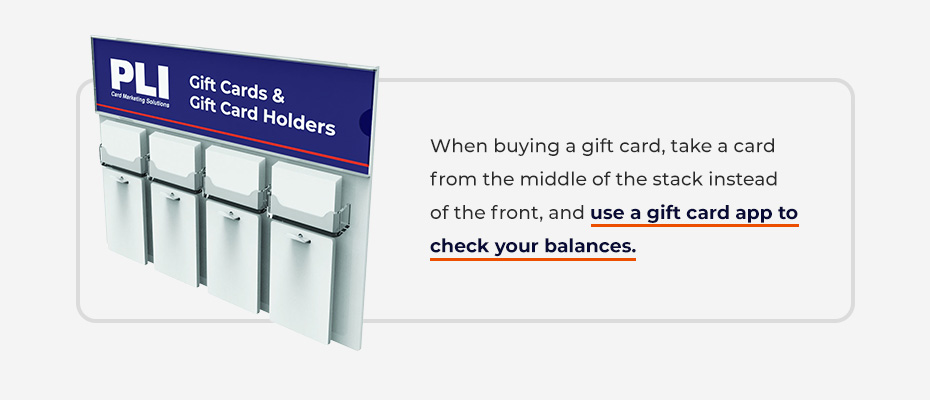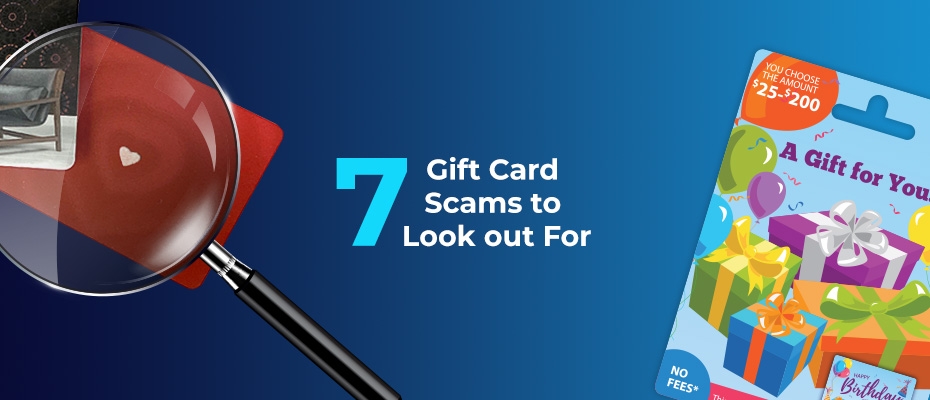
7 Gift Card Scams to Look Out For
Like credit cards and membership cards, gift cards are occasionally the target of online scammers. These types of scams can appear legitimate to vulnerable users, who wish they had known what to look out for with gift card scams after realizing their money is gone.
This issue is especially relevant to businesses that sell or deal in gift cards. Protect your business and employees from falling victim to a gift card scam with this advice.
What Is Gift Card Fraud?
Gift card fraud is any scam involving a person offering, requesting or stealing money via a fake, unusable or undeliverable gift card. It can also include stealing the victim’s private information or card number. The scammer’s goal is to get money quickly.
How Does Gift Card Fraud Happen?
Many business owners are surprised when they first learn that gift card fraud is a possibility, even with a card activation system in place. But what are gift card scams, and how do internet fraudsters successfully use them to steal your money and information? Below are some of the most common gift card scams to watch out for.
1. Requiring a Payment With a Gift Card
The victim purchases a gift card to pay for a fake product or service. The sales tactic is often high-pressure and could involve blackmail.
How the scam works: You receive a threatening message informing you that you must make a payment to avoid severe legal consequences. The scammer might pose as the IRS, a police officer or a legal representative working for your business. Then, they will ask you to pay using an iTunes gift card or through “MoneyPak,” where the scammer will direct you to send them certain gift cards.
How to avoid the scam: Regardless of the service, you should be able to make a payment using a method other than a gift card. If anyone tells you to pay using a gift card, the best action is to avoid responding or hang up the phone.
Due to this type of scam, the IRS has made public statements about fraudsters posing as government agencies online. The IRS advises you to ignore any seemingly genuine message from agencies received over the phone, email or social media.
2. Requesting a Three-Way Call to Check Your Gift Card’s Balance
The scammer steals the victim’s gift card balance when they attempt to sell the card on a classified ads website or another third-party site.
How the scam works: The scammer makes an offer and asks your customer to verify the gift card’s balance. Specifically, they want your customer to contact your card’s merchant line in a three-way call. The scammer records the touch tones the customer enters and uses them to pinpoint the gift card’s raw number.
How to avoid the scam: If a customer wants to get rid of a gift card, they should sell it to a reputable service or gift it to someone they know.
3. Stealing an Activated Gift Card’s Balance
The scammer steals gift card balances in one of two ways. They might work remotely, using a bot to search for a store’s recently activated gift cards, or they could go to the store, record card numbers and wait for a customer to purchase a card.
How the virtual scam works: You or your customer purchases a gift card legally, and the scammer looks up its valid number in the balance check system using hacking techniques. The scammer uses the card before its owner can or sells the card number illegally online.
How the in–person scam works: While browsing gift cards, the scammer stealthily takes a picture of the card and replaces it before anyone notices. Then, they wait for a customer to purchase the card and use it immediately after its activation.
How to avoid the scam: When buying a gift card, take a card from the middle of the stack instead of the front, and use a gift card app to check your balances. Report any incidents customers experience so the authorities can investigate the fraud.
This scam tends to be effective because unsuspecting customers often buy gift cards to give away. The recipients might wait to use them for so long that they can’t remember if the cards are still valid.

4. Tampering With the Gift Card’s Packaging
The scammer targets gift cards with scratch-off pads or other protective measures.
How the scam works: A scammer discreetly peeks inside a gift card’s packaging to find the PIN and waits for the card to become activated, proceeding with the above-activated balance scam. The scammer can re-cover the PIN with a sticker to make it look like the other cards.
How to avoid the scam: Avoid buying a gift card if the packaging looks distressed. If your store sells gift cards, make your employees aware of how a thief might attempt this scam.
5. Switching Cards When the Customer Checks Out
An employee steals customers’ gift cards at the point of purchase and replaces them with inactive cards.
How the scam works: A scammer who works at a store activates a gift card for a customer and swaps it with an inactive card. The scammer then uses the card, stealing its balance.
How to avoid the scam: When a customer returns with a gift card they recently bought, they should bring the receipt. Make sure the gift card number on the customer’s receipt matches the number on the card.
6. Selling Used Gift Cards
This scam involves selling a gift card number to a reputable third-party reseller and then quickly using the gift card once the payment goes through.
How the scam works: The scammer acquires a gift card and sells the code to your company. Your company confirms the card’s value and pays the scammer, who promptly uses the card before an unsuspecting customer purchases it.
How to avoid the scam: Collect gift cards using the best methods to deter scammers. Sell guaranteed gift cards to your customers.
7. Stealing Gift Card Information Using a Phishing Website
Some gift cards require online activation using the gift card’s number, expiration date and card verification code. This scam involves creating a copycat version of the site where users activate their legally purchased gift cards.
How the scam works: The scammer creates a duplicate of a legitimate gift card activation site using a deceptively similar URL and effective keyword targeting. Your customer finds the phishing website in their search engine results or accidentally mistypes the web address, then enters the card information for the scammer to steal.
How to avoid the scam: The customer can type the activation URL in as indicated on your card or use a smartphone to scan the card’s QR code.
Can Stolen Gift Cards Be Traced?
In the past, stolen gift card balances have been tricky or impossible to trace, making gift cards a prime target for scammers looking to make a quick purchase. However, as merchandisers work to combat known gift card scams, training exercises for employees and new methods of tracking buyer information have proven to be effective.
Make your employees aware of these scams and how to determine if a customer has fallen victim. Tell employees to question a high volume of gift card purchases, and limit the amount of money a user can put on a gift card.
PLI Card Marketing Solutions Provides Certified Gift Card Packaging Designs
Your business can design custom packaging for your gift cards. PLI Card Marketing Solutions imprints your brand’s image and logo on our card products. We design our gift card packaging with the latest card technology to protect against fraud and deliver secure transactions. Contact us to learn more about our products or order your company’s gift cards today.
Sources:
https://www.irs.gov/newsroom/tax-scams-consumer-alerts
Recent

LAS VEGAS, NV – June 5, 2025 - PLI hosted its first Town Hall of 2025 at both Las Vegas facilities.
6 Jun 2025
Gift cards have become an essential part of the retail and corporate gifting experience. To maximize their impact, businesses need more than just a simple rack or countertop placement.
2 Jun 2025
At PLI, we are committed to delivering best-in-class solutions that help our hospitality partners shine.
21 May 2025
In today’s fast-paced business world, finding the perfect gift, especially at the last minute, can be a daunting task.
19 May 2025
For the second year in a row, PLI is spending millions in capital to increase its G&L manufacturing capacity with the addition of a brand-new Bobst and an additional Pack-Smart machine. With the addition of these machines, we are not only ramping up our
13 May 2025
Gift cards are more than just a convenient way to give a present—they’re also an effective strategy for businesses to attract and retain customers.
12 May 2025
Gift cards have become one of the most versatile and appreciated gifting options in both personal and professional settings.
5 May 2025
LAS VEGAS, NV – April 21, 2025 - Who says the Easter Bunny only visits homes? This year, it made a special stop at the PLI Las Vegas Facilites and brought a basket full of fun with it!
21 Apr 2025
Newsroom


PLI Town Hall: Recognition, Results, and What’s Next
LAS VEGAS, NV – June 5, 2025 - PLI hosted its first Town Hall of 2025 at both Las Vegas facilities. | 6 Jun 2025

Leveling Up in Hospitality
At PLI, we are committed to delivering best-in-class solutions that help our hospitality partners shine. | 21 May 2025

PLI Adding More Capacity
For the second year in a row, PLI is spending millions in capital to increase its G&L manufacturing capacity with the addition of a brand-new Bobst and an additional Pack-Smart machine. With the addition of these machines, we are not only ramping up our | 13 May 2025

PLI’s Easter Egg-Stravaganza
LAS VEGAS, NV – April 21, 2025 - Who says the Easter Bunny only visits homes? This year, it made a special stop at the PLI Las Vegas Facilites and brought a basket full of fun with it! | 21 Apr 2025

Celebrating Valentine’s Day: A day of Sweetness and Team Spirit
LAS VEGAS, NV and ASHEVILLE, NC – February 14, 2025 - PLI’s Las Vegas and Asheville facilities came together to celebrate Valentine’s Day with a fun and festive event. | 17 Feb 2025

PLI Renews with the U.S. EPA SmartWay® Transport Partnership
LAS VEGAS, NV - January 9, 2025 - PLI has submitted and received approval for their current data submission to the SmartWay® Transport Partnership, an innovative collaboration between U.S. | 9 Jan 2025

‘Tis the Season for Gratitude: A Christmas Luncheon to Remember
LAS VEGAS, NV and ASHEVILLE, NC – December 23, 2024 – The holiday season was in full swing at PLI’s Asheville and Las Vegas facilities as the company hosted its Annual Christmas Luncheon for its employees. | 23 Dec 2024

Holiday Message from our CEO
As we approach the end of 2024, I am reminded of the extremely busy year we have had and to reflect on our successes as a company. | 20 Dec 2024





